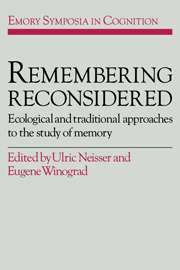Book contents
- Frontmatter
- Contents
- Preface
- List of contributors
- 1 New vistas in the study of memory
- 2 Continuities between ecological and laboratory approaches to memory
- 3 Memory for randomly sampled autobiographical events
- 4 Ordinary everyday memories: Some of the things of which selves are made
- 5 Walking in our own footsteps: Autobiographical memory and reconstruction
- 6 Memory observed and memory unobserved
- 7 The maintenance of marginal knowledge
- 8 The content and organization of autobiographical memories
- 9 The ontogeny of memory for real events
- 10 The functions of event memory: Some comments on Nelson and Barsalou
- 11 “The Wreck of the Old 97”: A real event remembered in song
- 12 Passive remembering
- 13 Remembering without experiencing: Memory for reported events
- 14 What is ordinary memory the memory of?
- 15 Go for the skill
- Name index
- Subject index
4 - Ordinary everyday memories: Some of the things of which selves are made
Published online by Cambridge University Press: 25 March 2010
- Frontmatter
- Contents
- Preface
- List of contributors
- 1 New vistas in the study of memory
- 2 Continuities between ecological and laboratory approaches to memory
- 3 Memory for randomly sampled autobiographical events
- 4 Ordinary everyday memories: Some of the things of which selves are made
- 5 Walking in our own footsteps: Autobiographical memory and reconstruction
- 6 Memory observed and memory unobserved
- 7 The maintenance of marginal knowledge
- 8 The content and organization of autobiographical memories
- 9 The ontogeny of memory for real events
- 10 The functions of event memory: Some comments on Nelson and Barsalou
- 11 “The Wreck of the Old 97”: A real event remembered in song
- 12 Passive remembering
- 13 Remembering without experiencing: Memory for reported events
- 14 What is ordinary memory the memory of?
- 15 Go for the skill
- Name index
- Subject index
Summary
This chapter is organized in three major sections. A brief review of our previous research is presented first. Next, new findings regarding the nature of self-selected events and memory for those events are reported. This section is based on the diaries of four women who kept written records of memorable daily events. Two recognition-memory posttests were given following 2 weeks of record keeping. On each posttest, original records were presented for verification, together with foil items. Foils derived from the participants' actual records were designed to show that the meaning of daily events is preserved in personal memories. This section includes an ethnographic-type description of self-selected daily events and activities. The accidental and tragic death of the parent of one of these women unfortunately occurred during data collection. Because she and another participant were both keeping records at the time of the accident, we were able to investigate the impact of a highly significant life experience on memory for everyday events in a controlled case study.
Introduction
The content of much human cognition is represented as a rich collection of autobiographical memories. Certainly, some of these memories are of formative life experiences, although many more appear as insignificant happenings. If these seemingly unimportant, ordinary everyday memories are considered alone, or isolated from the mosaic of one's personal recollections, they may be interpreted as trivial fragments of the past, but in the context, flow, and rhythm of daily life they become the fabric of a self-knowledge system.
- Type
- Chapter
- Information
- Remembering ReconsideredEcological and Traditional Approaches to the Study of Memory, pp. 91 - 125Publisher: Cambridge University PressPrint publication year: 1988
- 32
- Cited by



